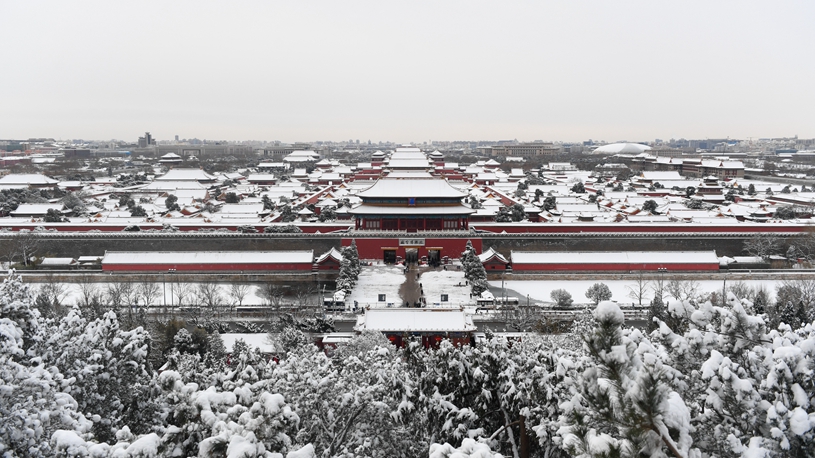Born and bred in Chinese society, these new forces are fueled by China's stellar achievements in groundbreaking scientific research, seamless coordination and eco-friendly initiatives. And China is now entering a new stage of growth that focuses on high-quality development.
BEIJING, Feb. 21 (Xinhua) -- Ever since Chinese President Xi Jinping introduced the term "new productive forces" in September last year, foreign think tanks and media outlets have widely discussed the concept. In a recent high-level meeting, new productive forces were again the focus of discussion, bringing attention to its various implications.
What is the true meaning of the term? More importantly, what is conveyed through it?
NEW GROWTH DRIVERS
It was in Northeast China that Xi first proposed the concept of new productive forces during an inspection and research trip. The term's birthplace was no coincidence.
Despite the Northeast region's vital role in China's heavy industry, the shift away from traditional growth drivers has lagged in recent years, posing challenges to its development.
New productive forces were needed for economic growth. The term continued to emerge in government meetings as vital for regional and national growth.
With innovation leading, new productive forces mean advanced productivity freed from traditional economic growth models. It features high technology, high efficiency, and high quality and aligns with the country's new development philosophy, said Xi.
The term refers to new productive forces that emerge from continuous breakthroughs in science and technology, driving strategic future and emerging industries that may introduce disruptive technological advancements in an era of intelligent information.
Born and bred in Chinese society, these new forces are fueled by China's stellar achievements in groundbreaking scientific research, seamless coordination and eco-friendly initiatives. They are the engines behind China's pursuit of high-quality development, ensuring that the fruits of economic growth reach the people and freeing the economy of traditional constraints.
WHY THE PARADIGM SHIFT?
China is now entering a new stage of growth that focuses on high-quality development.
Although the country faces internal and external challenges regarding its economic growth and future development, China's economy grew by 5.2 percent in 2023, dismissing claims its economy is collapsing.
However, China must develop new growth forces with global economic growth slowing down.
Pan Helin, a researcher at Zhejiang University, said new productive forces have become a buzzword on local government agendas as China pivots to a growth model that prizes quality over quantity.
"Chinese localities are under pressure in the economic transition. The new productive forces are expected to boost economic growth and help win over regional competition," Pan said.
"China has immeasurable potential and strong competitive edges in developing new productive forces, which could become a new growth pole of the Chinese economy in the near future," said Ming Ming, chief economist at CITIC Securities.
Therefore, developing new productive forces is a requirement for governments across China, with high-quality development an unyielding principle in the new era.
WHAT'S NEXT?
At the birthplace of the "new productive forces," a recent tourism boom is underway.
Once spurned by winter travelers, millions of tourists have flocked to Harbin, capital of northeastern Heilongjiang Province, for the city's ice festival, where a total tourism revenue of 5.9 billion yuan (828 million U.S. dollars) was generated by 3 million visitors in three days when the year 2024 began.
The success of Harbin's efforts to rebrand and woo visitors to showcase its icy landscape, culture and culinary delights reflects efforts to develop new productive forces and embrace innovative, coordinated, green, open and shared development.
Amid this industrial transformation, technology holds the key to developing new productive forces.
Data from the National Bureau of Statistics show that China's total expenditure on research and development (R&D) in 2022 grew by 10.1 percent to over 3 trillion yuan from the prior year, with 84 percent of this growth coming from enterprises. The country also tops the world in the total number of R&D personnel.
To further leverage innovation and speed up the development of new productive forces, China has established sci-tech partnerships with more than 160 countries and regions worldwide in clean energy, artificial intelligence and biomedicine.
These investments in R&D and global partnerships have paid off.
Last August, Huawei, a leading Chinese telecom entity, overcame U.S. chip ban and released a smartphone capable of 5G internet speeds, shocking the world.
Electric vehicles, solar batteries and lithium-ion batteries, categorized as China's tech-intensive and green "new three," reported a combined export value of 1.06 trillion yuan (150 billion dollars) in 2023, jumping 29.9 percent year on year.
Shenzhen-based automaker BYD, China's EV giant, has topped the world in EV sales, overtaking Tesla for the first time in the fourth quarter of 2023.
Nationwide, China has demonstrated "strong momentum and broad prospects" in developing new productive forces, the backbone of which are strategic emerging and future industries, said Cai Wei, chief strategy officer of KPMG China Advisory.
As emphasized by Xi, China will prioritize scientific and technological innovation, accelerate efforts to build high-level self-reliance and strength in science and technology, and make breakthroughs in core technologies.
Moreover, China is gearing up to revitalize its digital economy, promote green initiatives, reform its relations of production, and foster a dynamic synergy among education, science and personnel training. These initiatives are already underway.
According to official data, the share of strategic emerging industries, such as new energy, high-end equipment and biotechnology in China's gross domestic product rose to over 13 percent in 2022 from 7.6 percent in 2014. China plans to raise that ratio to over 17 percent by 2025.
The rise of new productive forces signals a transformative shift in China's economic landscape, replacing antiquated growth drivers with more dynamic ones and setting the stage for more sustained and robust economic development in the years to come.■












